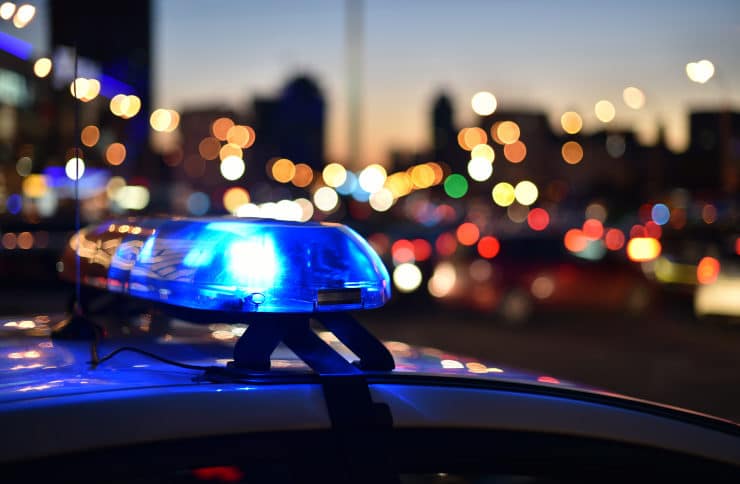
This Nevada Revised Statute pertains to pulling over when there is an emergency vehicle with flashing lights. Even if there was no rule or law guiding us to pull over, our instincts would probably force us to. When there is an emergency vehicle like a police car, big firetruck or ambulance with screaming lights blazing right behind us driving at a fast rate of speed our natural instinct is to get out of the way.
So hopefully you will not get a traffic ticket for this. Sometimes mistakes can happen and if you are not paying attention to your surroundings or have your radio set to a high decibel level it is quite possible that one of these emergency vehicles can sneak up behind you without your knowledge. If you impede the emergency vehicle you could be cited. Even though the instinct is to get out of the way, NRS 484B.267 dictates that you move to the right side of the street and stop.
It can be a tricky situation because other traffic could be in the lane and with the abrupt changes and lights flashing there could be lots of disorder. It is an easy situation to get disoriented when you might not be thinking clearly. Hopefully in that type of situation, if you did make a judgment error, a police officer would give you a break and not issue a ticket.
If a traffic citation was issued then your next step should be to contact Ticket Busters for assistance. We can help you try and get the ticket reduced which would save you money and time.
In any case, when you see the emergency lights in your rearview mirror you should start to slow down and check your surroundings paying extra attention to the lane to your right so you can safely pull over without causing an accident. Once you are off to the right, you should come to a complete stop until all emergency vehicles have passed. This is the proper way to abide by the law as it is set up that you do not cause any distractions or impediments to the first responders which allows them to get to the scene where they are needed most more quickly. In an emergency situation, someone is likely in a desperate situation and literally, every second could mean life or death which is why this law is so important as it helps ensure emergency vehicles can move quickly and efficiently.

Often times when drivers have emergency vehicles bearing down behind them they will simply move to the right but not stop and instead will only slow down. That can be dangerous if automobiles in front of them are stopped (properly following the law) and it can also make the first responders slow down which in turn delays them from getting where they need to get to.
If you are seen conducting this behavior by law enforcement they will most likely issue you a traffic ticket. If you failed to abide by any traffic law and are given a ticket by law enforcement you should note that you do not have to face the penalties alone.
You can contact us at Ticket Busters and we will help you lower the consequences of your action and if needed will provide a strategic defense to get the citation reduced or sometimes even dropped completely.
Many believe that if there is an emergency, police officers are less likely to cite a driver for violating a Nevada Revised Statute as their attention will be on the crisis at hand and not on drivers making minor flaws to the law.
That is a bad assumption as many law enforcement personnel will be more upset that a law endangering or impeding an emergency vehicle is being broken which can actually increase the odds of a driver being ticketed. If something along these lines occurs and you contact Ticket Busters we will reach out for additional evidence that will verify you were in the wrong. Often times, surveillance footage from nearby businesses or traffic lights can be utilized as well as witness testimony.
The verbiage from NRS484B.267 reads as follows:
“Upon the immediate approach of an authorized emergency vehicle or an official vehicle of a regulatory agency, making use of flashing lights meeting the requirements of subsection 3 of NRS 484A.480, the driver of every other vehicle shall yield the right-of-way and shall immediately drive to a position parallel to, and as close as possible to, the right-hand edge or curb of a highway clear of any intersection and shall stop and remain in such position until the authorized emergency vehicle or official vehicle has passed, except when otherwise directed by a police officer.”
As we spoke of earlier in this article, when emergency vehicles are approaching with their lights flashing, drivers must pull over and pull over to the right. This statute really applies to any official vehicle that has flashing lights and is using them.
So, if an ambulance or a police car is driving behind you there is no need to pull to the right unless the car’s lights are flashing. As a matter of fact, abruptly pulling off to the right and coming to a complete stop will most likely garner you a traffic ticket if it doesn’t cause an accident first.
Sometimes people get nervous when there is a police car or other type of emergency vehicle behind them but there is no need to. Only when the lights are flashing does this Revised Statute come into play.
Some emergency vehicles are ‘unmarked’ meaning they may not specifically state that they are part of the typical police fleet. Although unmarked, they may have a light on top and sometimes that top can be placed by the driver on the spot. So to reiterate, if those lights are flashing you need to adhere to the rules even if the actual car does not look like an emergency vehicle.
Providing the right of way to these emergency vehicles is crucial on a couple of fronts.
First off, the reason the first responder’s lights are on is because there is a crisis somewhere that needs to be immediately addressed. By yielding to these types of vehicles, you are allowing them to get to the scene as quickly as possible which could save someone’s life.
Also, the laws are in place for a reason. Although these statutes were written up for specific reasons they all encompass the Rules of the Road. If all Nevada drivers are following these rules and one person makes up their own rule on the cuff during a hectic situation it can cause danger to everyone. Not only is a car wreck more apt to occur but the first responder can be delayed which in turn could cause additional damage to the emergency which has already taken place.
Sometimes a misjudgment can occur and if that happens in front of a law enforcement officer you might get ticketed. In that scenario, fines and court appearances may be in your future as well as traffic school. You have options if this happens with the first one being to just simply pay the fine and deal with all of the consequences.
Another option, one that is more feasible and beneficial to you is to call Ticket Busters and let us help you in this process. Our professional staff deals with these types of cases day in and day out so we know the best steps to make your life easier in dealing with the court system.
It may or may not be a surprise to some readers that there is actually a specific NRS that defines what an emergency vehicle is. So, if you are ticketed for failing to yield to an emergency vehicle and call Ticket Busters for help, one of the things our law professionals will most likely do is to ensure that the emergency vehicle that you failed to yield to was in fact an emergency vehicle as described in the law.
The statute that makes this definition is NRS 484A.480. It is a pretty long statute so we will not go into details here but there are a few things you should be aware of (certainly the Ticket Busters staff will want to know):
“To be considered authorized, an emergency vehicle must have at the very minimum one flashing red light. It must also be equipped with a warning lamp that is visible from the front of the automobile and includes a siren.”
For official status, the emergency vehicle must be permitted by the Department of Public Safety. There are some additional NRSs that define exactly what the permit process consists of.
An official emergency vehicle can be maintained partially or entirely by different entities including the State, a county or city or even by private ownership in some cases. If the privately owned vehicle is used by a regularly salaried member of a police department, sheriff s office or traffic law enforcement department, then it could be considered an official emergency automobile.


